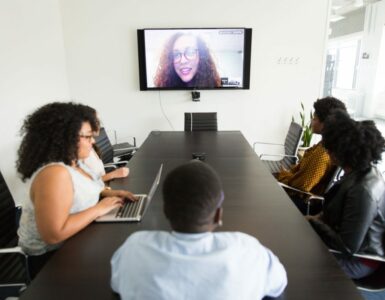There can be a lot of awkward moments during conference calls, but you can do something to prevent them as much as possible. Communicating with people without seeing their nonverbal cues such as hand movements and facial expressions can be difficult. If you use these tips for better communication during conference calls you’ll avoid many problems that usually happen.
1. Apologize for any disruptions
If any factors are disrupting your call you should apologize to all attendees. Preferably, you should take calls in a quiet place indoors, but if that’s not an option, be upfront about it. Acknowledge all backgrounds noises so that no one thinks that there are problems with phone systems or that you’re acting disrespectful. Simply say where you are at the moment and apologizes for the noises right away.
2. Make sure that everyone knows who’s attending
All attendees should be informed about the participants of the call. You can send invites that include time, date, the estimated duration, and the list of participants. This is common courtesy and one of the tips for better communication during conference calls. You should know your audience and prepare accordingly, just like all the other attendees.
3. Don’t skip the introduction
Whether you introduce yourself or another team member introduces you, this is the part that you don’t want to skip. Identifying people only by the sound of their voice can be difficult and create confusion. When someone introduces you, say something, even if it’s just a simple “Hello” so that everyone can hear your voice. If you’re talking to people you don’t know, make sure that everyone states their name, job title, and interest in the discussion.
 4. Talk loudly and make pauses
4. Talk loudly and make pauses
People shouldn’t have trouble hearing you, so speak loudly at a slow rhythm and take pauses while you talk.
Make sure that the phone is as close to you as possible, especially if your voice is soft. Even deep voices can be hard to hear during conference calls. Speak clearly and make sure that everyone can understand what you’re saying.
5. Talk about what you’re doing
While moments of silence aren’t such a big deal during in-person meetings, they can cause confusion during conference calls. Attendees might assume that you’re having technical difficulties or that you’re simply unresponsive and maybe even rude. When you need to do something talk about what you’re doing.
For instance, you could say that you’re searching for an email, that you are looking for the attached document, and so on. Just make sure that there’s no dead air. If you really can’t say anything for a while, let the others know by politely saying that you need a second to think about the subject. This is one of the best tips for better communication during conference calls because no one likes dead air during these meetings.
6. Don’t have a conversation with just one person
If there are a lot of attendees of the conference call, don’t put all your focus on one person. You shouldn’t have a long conversation with just one person, especially if the conversation is of no interest to others or if it’s unrelated to the subject. You can tell the person you’re talking to that you’ll continue the conversation after the conference call is over.
Don’t make all the other attendees feel like you’re wasting their time, and stick to the agenda. Due to technical difficulties, there are often things that waste everyone’s time so bringing those that are in your control to the minimum is one of the tips for successful conference calls.
7. Summarize and say goodbye
Tips for better communication during conference calls include summarizing what has been said at the end of the meeting. Make sure that everyone has remembered what their tasks are and remind them again with an email containing the summarized conference call. People rarely remember everything that has been said, so a small reminder always comes in handy. You should also make sure to end the conference call by saying goodbye. A formal goodbye is a good idea whether you’re in charge of the conference call or you’re one of the participants. Let everyone know when you’re signing off and, if needed, schedule another meeting right away. If that is not an option, you should mention when the next call should take place. For instance, you’ll discuss the next steps when the presentation is done. All that’s left is to follow through with promises if you’ve made any during the call. If you’ve said that you’ll send an email, send it.












